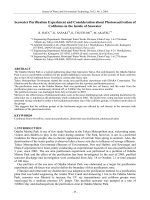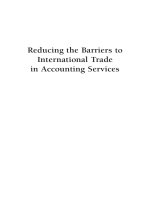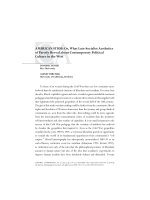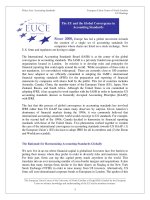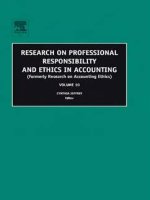Arguments about approaches compile FS in accounting
Bạn đang xem bản rút gọn của tài liệu. Xem và tải ngay bản đầy đủ của tài liệu tại đây (200.02 KB, 16 trang )
Table of content
I/ Introduction.
1. Accounting/ methods to measure
1.1 Accounting
1.1.1 Present value approach
1.1.2 Fair value approach
1.1.3 Current cost approach
1.1.4 Historical cost - historical amortized cost approach
2. Intangible assets
II/ Main Body
1. Historical cost
1.1 Formula
1.2 Arguments about historical cost
2. Fair value
2.1 Formula
2.2 Arguments about fair value
3. Intangible assets
3.1 Importance of intangible assets
3.2 Kinds of intangible assets
3.3 Issues about intangible assets
3.3.1 Reasons
3.3.2 Consequences
III/ Conclusion
IV/ Reference
I/ Introduction
In nowadays worldwide market, accounting plays a significant role in a
company's future. It is believed that the production and transmission of information
about an enterprise are include in that enterprise's financial statements which can be
compiled by several approaches to determine values of assets on balance sheet. These
approaches include historical cost, current cost, fair value and present value
approach. Each of these approaches has its own advantages and disadvantages in
describing a company's real financial position. However, some recent arguments
believe that the method of using historical cost approach could not give the correct
financial position of a company. The argument may be true in some case, but it is
undeniable that this approach also has advantages for accountants to use. Therefore,
this paper will discuss effects of historical cost approach in compiling a company's
financial statement in order to decide whether historical cost approach is an
appropriate method to pinpoint the financial position of a business or not. Moreover,
argument of some certain intangible assets are not recognized on balance sheet will
seriously understate true value of that entity will also be discussed.
The research about historical cost and intangible assets focuses on three main
objectives, which are determining approaches to calculate the value of an asset,
identifying the pros and cons of historical cost and fair value approach, and finally
adjusting what intangible assets are not recognized on balance sheet and how it
understates the true value of a company. However, due to the limit of time and
human resources, the study still has limitations in the output. The research mostly
concentrates on analysis of historical cost and fair value, as well as intangible assets
which are not recognized on balance sheet. The paper then cannot include analysis of
other approaches in compiling a company's financial position. It is recommended that
later researches should focus on providing further knowledge about remained
approaches in particular dimensions.
1. Accounting/ methods to measure
1.1 Accounting
Accounting is an important factor of any business in worldwide market
nowadays. It is significant that an organization could not accomplish its strategy
without accounting information. In accordance with the development of international
economy, importance of accounting information has become greater leading to
various understandings of accounting. Accounting was defined by The American
Institute of Certified Public Accountants (AICPA) in 1953 as follows
"..Accounting is the art of recording, classifying, and summarizing in a
significant manner and in terms of money, transactions and events which
are, in part, at least, of a financial character, and interpreting the results
thereof." (Cited in Naseem Ahmed, 2008, p.3)
Rechard Wittsiepe (2008, p.7) cites the definition of Accounting by the
American Accounting Association (AAA) as "the process of identifying, measuring
and communicating economic information to permit informed judgements and
decisions by users of the information". Accounting can be also understood as a
service activity, which provides useful information about entities in making
economic decisions among courses of action ( AICPA definition in Jack Quarter,
Laurie Mook, Betty Jane Richmond, 2003, p.42)
Accounting, therefore provides useful information to decision makers. It is
clearly that accounting provides quantitative financial information that the users in
making better business decisions. In addition, through measurement, classification
and classification the mass of data of a company, accounting helps describing,
analyzing and compiling that data into financial reports and statements that identifies
the financial condition and results of operations of the company. The information
system produces and transmits information about an enterprise to a wide variety of
interested parties. The needs of users to whom accounting is addressed are very
diverse, so financial statements in the public domain should be able to satisfy most
needs.
Measuring accounting is an important step which can affect the future of a
company.
The financial statement, then can be compiled by several methods
including present value, fair value, current cost, and historical cost to determine the
value of an asset. Each method has its own characteristics, disadvantages and
advantages which will be discussed as followings.
1.1.1 Present value approach
Present value is the current value of a future amount of money. This approach
has advantages in showing a cash flow at a certain time in the future and calculating
the cash flow's present value. Calculating the present value assumes that the investor
knows both the future amount and the applicable interest rate or rate of return.
However, there still be questions remained in whether information collected through
present value is reliable or not, since it mainly focuses on evaluating the value of
future amount of money in current position without considering the previous figures
and facts
1.1.2. Fair value approach
IFRS 13 defined Fair value as the amount for which an asset could be
exchanged between knowledgeable and willing parties in an arm's length transaction.
The definition is nor significantly different from other definition by FASB in 2006 as
the price that would be received to sell an asset or paid to transfer a liability in an
orderly transaction between market participants at the measurement date.(John
Dorchester Jr, 2011). The advantages of fair value includes the accuracy of value of
assets and liabilities since they are traded in an arm's length transaction. It is also
claimed to provide users with more relevant information since fair value utilizes
specific information in current market conditions. However, disadvantages of fair
value approach is also clear. One of the disadvantages of fair value is its pricing
deviation which is vagueness of the measuring process of financial statement. Other
major disadvantage of fair value is the limited reliability which makes the value turn
out to be inappropriately optimistic since the information provided in financial
statement is reliable and relevant only for a short period. (Miroslav Škoda and Peter
Bilka, 2012)
1.1.3. Current cost approach
Current cost is defined as the price must be paid for an asset or its usage at the
date of the balance sheet (Henrdicksen and Breda, 1992, p. 426). It is the cost based
on the prevailing price paid for assets, stock, raw materials etc. as opposed to their
historical cost. Current cost method is said to have advantage in providing a better
measure of efficiency and supporting in decision making. Despite the advantages of
current cost method, it is also received some criticism. Current cost is claimed to be
very subjective (Edward et. al.,1981, cited in Bakar N. B. Abu, 2007). It is also
concluded that information in financial statement compiled by current cost approach
is only relevant for short-term decision.
1.1.4 Historical cost - historical amortized cost approach
Among four methods to measure accounting, historical cost could be
determined as the most common one. Historical cost is defined as a measure of value
used in accounting in which the price of an asset on the balance sheet is based on its
original cost when acquired by the company. (Bessong P. Kekung and Charles
Effiongaicpa, 2012). Historical cost has advantage in the relevance for making
economic decisions, and it is useful for control purpose. This method is favored of its
reliability because the information in financial statement held at historical cost is
based on transactions that have already occurred which are verifiable and free from
management bias. In contrast, financial statements using historical cost method is
criticized to be misleading since it cannot ensure the quality of justice and honesty
within such information. It is clear that this kind of method is commonly used by the
accountants, however, there are many arguments about the effectiveness of this
methods. Questions about whether this method is still helpful or not are raised among
accountants, and that could be further discussed in next part of this paper.
2. Intangible asset
Intangible assets are studied in a large numbers of researches during the last
two decades. Intangible assets are assets without physical or financial embodiment
involving in many processes as well as areas of economy. They are described as nonfinancial assets without physical substance using for production of goods or services,
rental to others, or administrative purpose (Epstein and Mirza, 2005). Evidence from
the development of numbers of countries suggests that intangible assets are so
important to companies that they encourage investment grow faster than tangible
assets. It is because intangible assets can easily be converted into tangible assets to
create revenue. They are also of considerable interests to investors. For the benefits
of intangible assets, it is understandable that
II/ Main Body
1. Historical cost
As previously mention, historical cost is the traditional method of recording
assets at the original cost. It means that when an enterprise purchases a product, it is
written in the enterprise's balance sheet as its historical cost. Historical cost method is
considered as a good basement for any cost approach procedure, and it measures the
actual costs occurred during the development of intangible assets. (Céline Lagrost,
Donald Martin, Cyrille Dubois, Serge Quazzotti, 2010). Historical cost have both
advantages as well as disadvantages.
1.1. Formula
The formula to compute the estimated historical cost of an asset using the CPI
is as follows:
Estimated Current x Index Rate for Estimated ÷ Index Rate for = Estimated
Historical Cost Year of Acquisition Current Year Cost
Example: The estimated or actual year of acquisition of an asset is 1950. The
purchase price of the same asset in 2002 is $90, 000. The estimated historical cost of
the asset in 1950 would be computed as follows:
$90,000 × 72.1 ÷ 538.8 = $12,043
The very important thing when focus on this kind of method is that it relates to
a large area of finance. Property, plan and equipment, salary and compensation, or
most significantly intangible assets can be examples of fields in which this kind of
method is used to measure. Through it, accountants realize the significance of such
fields in the development of an enterprise. However, it is undeniable that this method
brings negative effects to the company. Accountants realizes the advantages and
disadvantages of historical cost in nowadays financial world.
1.2. Arguments about historical cost.
Some arguments accept this kind of method believe that it has lots of positive
effects on the measurement of financial area of a company. The very first argument
believes that historical cost play an important part in making economic decision as
well as giving experience in the establishment of a financial statement. The reason
for the importance of historical cost in economic decision making is related to three
manners. Historical cost relates to the evaluation and selection of decisions in the
past. The results of these past decisions will determine which rules current economic
decisions should follow. Furthermore, an economic decision would not be made if
there were no forecast for future prices. Historical cost is then considered as the basis
knowledge to make the forecast of the prices of assets in future. Finally, through
historical cost, accountants could have a precious lesson from errors in decisions
made previously. Another argument shows that historical cost keeps accounting
measurement objective and verifiable. (Anao, 1989, p. 14-23). Accounting is seen as
involving stewardship function of management. Historical cost which bases on actual
transactions gives managers records of all the assets and liabilities at the exactly
price. This help managers to avoid the manipulation in using figures for accounting.
Historical cost is also considered as manner to evaluate the effectiveness of what
managers have accomplished, and at which levels they have met their responsibility.
Finally, this kind of approach is easy to establish since it mainly focus on the
transactions made in the past, which bring the convenience for users to utilize such
approach.
Although historical cost has been used for decades, some people argues that
historical cost is no longer suitable for a successful company. This method is
criticized mainly from proponents of current cost accounting. Historical cost's first
disadvantage is the irrelevance to decision making. This disadvantage point seem to
confused with its advantage. Although accounting bases on the stewardship function
of management, it is understandable that accounting also bases on other factor, for
example, the increases and decreases in the value of accounting investment.
Transactions in the past is not enough, but current position and assets in financial
area of the company are also necessary. Historical cost is also criticized to be
misleading. The value of intangible assets in balance sheet are unrealistic since it
follows historical cost approach. The historical cost cannot guarantee whether
information written in balance sheet is justified and honest or not. In result, the
misleading of historical cost leads to over payment of taxes, dividends and wages
during up-ward change in price. In addition, historical cost cannot evaluate the
inflation in nowadays economy. Effects of inflation are not the same for all the
companies in the market, and historical cost accounting become almost unhelpful in
the comparisons of enterprises' performance. In the 1980s, many blamed historical
cost accounting for not being able to report potential losses from innovative financial
instruments in a timely manner.(Yi-Ping Liao, 2013). Finally, historical cost no
longer reflects economic reality. As said before, historical cost bases on transactions
in the past, which is not the only factor in nowadays financial industry. Historical
cost does not recognize current market value. It ignores the possibilities that current
market value of assets may be higher or lower than suggested.
2. Fair value.
Fair value is defined before as the price that would be received to sell an asset
or paid to transfer a liability in an orderly transaction between market participants at
the measurement date. Although fair value is an appropriate approach for accountants
to utilize in balance sheet, this method has not become the main method of
accounting in some countries and it is questionable whether it will be used in some
days. Following evaluation of advantages and disadvantages of fair value method
supports in answering that issue.
2.1 Formula
The calculation of fair value is relatively simple as long as you have access to
the necessary underlying data. The formula most often used is:
Fair value = Cash × (1 + r × x) ÷ 360 – Dividends
While Cash is the closing index value, r is the current interest rate, and x is the
time remaining until the contract expires, in days.
For example, the fair value calculation for the Stock market index of 100 UK
market companies (FTSE) where the closing price is 1157 points with a cash index of
1146, the interest rate is 0.57%, with 78 days before expiry of the contract, and a
dividend value of 3.47 points, would be calculated as follows:
Fair value = 1146 × (1 + 0.0057 × 78) ÷ 360 – 3.47
This calculation gives a fair value of 1156.68 points. If the FTSE is trading at
1157 then the difference between the two figures is 0.32. At this time, the stock is
trading below fair value.
2.2 Argument about fair value.
The most advantage of fair value is the accuracy of value of assets and
liabilities. Fair value is thought to be reliable and verifiable. Since assets and
liabilities in a company are traded in an arm's length transaction if follows fair value,
accountants can check information about both current and past market prices.
Financial Accounting Standards Board (FASB, 2000, p. 8) has stated that its longterm goal is to have all financial assets and liabilities recognized at fair values. The
second argument for fair value accounting is that it provides more information on
balance sheet that historical value. Beside the figures and facts of financial position
of a company in the past, fair value also requires extensive information about risks
and opportunities, methodology and assumption of the financial statement of the
company. It enhances the company's financial statement in order to bring more
overall view of that firm financial position than historical cost. Fair value is also
claimed to provide users with more relevant information since it utilizes specific
information in current market conditions. The value of this approach in giving
information for a firm evaluating the results of financial activities is also taken into
considerations of accountants. Further, fair value accounting reduces the risks of
being manipulated in the financial facts of a company. Using fair value accounting,
the increase or decrease of net income in a company is reported in exactly timeline
when it occurs.
Finally, from a long-term point of view, the approach affords a means of
evaluating the firm as a going concern.
Although fair value has lots of advantages in compiling financial statement of
an enterprise, it also faces criticisms. Here are the disadvantages of this kind of
approach. One argues that fair value's pricing deviation which is vagueness of the
measuring process of financial statement. The next argument against fair value is that
it also gives misleading information. The method only reports the achievements and
losses when they occur, which bring the question about the ability to forecast future
situation of worldwide market. So the market change which can be affected by other
factors of the financial industry may be inefficient, and not reflect in its estimates.
Despite the positive effect of fair value in helping avoiding manipulation, there still
be a risk in adopting a fair value estimates because in financial market, trading by
firms can have an effect on both traded and suggested prices. Other major argument
against fair value is the limited reliability which makes the value turn out to be
inappropriately optimistic since the information provided in financial statement is
reliable and relevant only for a short period (Miroslav Škoda and Peter Bilka, 2012).
This is the common disadvantage of both historical and fair value approach. The
financial statement conduct in fair value approach would be appropriate for a short
period of time, while market environment change every day. The change; therefore,
causes confusion of whether previous financial statement is suitable for applying in
current situation or not. The writer believes that both fair value and historical cost
have some similarities in their advantages and disadvantages. Through a set of
advantages and disadvantages of these two approaches, in the author’s observation,
overall fair value accounting benefits investors more compared to accounting based
on alternative measurement attributes, including historical cost accounting.
3. Intangible assets
3.1. Importance of intangible assets
In nowadays market, assets and liabilities of a company are considered as key
factors to the company's success in the area of finance. Especially, the intangible
asset is proved to be a special driving force to the future of that company. So what is
an intangible asset? Intangible assets are described as “non-physical sources of
expected benefits”. (Zambon, 2003). Intangible assets come in the form of
intellectual property, skills, knowledge and attitude of staff in a company. According
to Phil Preston (2011), intangible assets account for up to 80% of stock market
valuations in developed countries. The instance of intangible assets of Coca-Cola is
given to clear the importance of this kind of assets. According to Stock Analysis on
Net (2013), intangible assets of Coca Cola can be divided into three categories
includes intangible assets with definite lives subject to amortization, intangible assets
with indefinite lives not subject to amortization and goodwill. After considering
figures and facts combining with the history of intangible assets, the company
realizes that its intangible assets is a significant part of the company. Intangible
assets is determined by Coca Cola can be amortized, primarily on a straight-line basis
through their
lifetime and they varies from 1 to 20 years. The company,
understanding the importance of these assets, is taking the matter of recognizing the
value of these assets into consideration.
3.2 Kinds of intangible assets
Intangible assets are divided into three categories: Intangible assets with legal
rights, Goodwill or Non-separable Intangible Assets, and separately identifiable
Intangible assets. Warfield, Terry D. and Weygandt, Jerry J (2001) shows the basic
knowledge about intangible assets:
Chart 1. Intangible assets
(Source: Warfield, Terry D. and Weygandt, Jerry J, 2001)
The Chart give five types of intangible assets, including marketing - related,
customer-related, artistic-related, contract-related, technology-related, and goodwill.
3.3. Issues about Intangible assets.
Intangible assets is implied to be most valuable object in the creation of
advantages in competition of a company. Lots of economic regulations recognize
those assets as parts of value of assets. The key regulation that accept the value of
those can be listed as IFRS, GAAP, etc....It means that the rules setters are now
recognizing the importance of such assets in the development of a company.
However, the rules to recognize intangible assets are much more stringent. All the
intangible assets is not always capable of being evaluate. Current accounting
standards do not recognize a value for certain intangible assets (Saoussen Boujelben,
Hassouna Fedhila, 2011). Indeed, the value for certain intangible assets is generally
left unmeasured since the rule makers confirms that such issue is difficult to identify.
Lev and Zarowin (1999) assumes that accountants' refusal to recognize some of the
intangible assets seriously understates the true value of that entity. There are
intangibles assets specifically listed in IAS 38 which are not recognized in the
identifiability criteria. Reasons and consequences for the refusal to recognize the
intangible assets' value would bring a further knowledge of the importance of
intangible assets.
3.3.1. Reasons
There are several reasons why intangible assets may not be concentrated as
well as they are hoped:
First, financial rule makers refuse to recognize certain intangible assets
because of the lack of visibility. As defined, intangible assets are assets without
financial embodiment, so they are not always easy to see. Although intangible assets
rarely add isolation value, they have capability in adding immense value with other
assets. However, that is also the reason for the overlooking of intangible assets.
Second, Intangible assets are partly ignored for their uncertain value
contributing in the development of a company. Since intangible assets cannot be
easily recognized, they are too complicated and subjective for accountants to assign
their value, though there are some exception such are Goodwill, license fees that
accounting standards can be applied.
Third, because intangible assets lead to the conflicting timeframes, they need
time to develop. While other assets take a short period to develop, this kind of assets
requires a longer time to develop their lifecycle. In result, they might not receive the
priority and focus that they deserve.
Finally, though not have separate names, some assets have different roles in
the process of forming financial advantages of a company, the cost to establish and
develop such assets would not be recognized at the same levels. This leads to the
difficulty in separating the value and costs of these assets from other assets
3.3.2. Consequences
The refusal to recognize value of a certain of kind of intangible assets means
that numerous companies will have higher net worth appraised by the stock market
than the net worth as appraised by the current accounting standards
It is also claimed that ignoring their value results in a decrease in the true
value of an entity. This can be more serious in case of a big company like Apple Inc,
Google Inc, or Microsoft Corporation which have billions of net worth based on
intangible assets.
Through the evaluation in intangible assets, its is a difficult challenge to
recognize that intangible assets drive business valuations and put strategies in place
to manage and develop them.
III/ Conclusion
The paper discuss about two main issues raised in nowadays worldwide
market, surrounding approaches in compiling the financial statement of a company,
and intangible assets. Before coming to the main body of the research, it is essential
to have basic knowledge about the issues discussed, objectives, questions, limitations
as well as significance of conducting this research. Overall understanding about the
problem discussed in this paper is also clarified. Despite the importance of
accounting approaches, some argue that present method of compiling a company's
financial statements using historical cost or historical amortized cost approach no
longer gives the correct review of the real financial position of a company. There also
argument that the refusal to recognize value of certain intangible assets could
seriously understates the true value of that entity.
The paper firstly introduces the overall understanding of the area in which
some financial approaches are applied - Accounting. It is clear that accounting plays
a significant role in the development of an enterprise. The reason supports the
importance of accounting is that it provides necessary information in the process of
decision making. Moreover, accounting helps in the compiling process of a company'
financial statements.
For the purpose of accomplishing accounting role, there are four available
methods including historical cost, current cost, fair value and present value approach.
These four method would be clarified in term of their definition, advantages and
disadvantages to apply into practice. It is ensured that the process of utilizing these
approaches in developing the financial statement requires lots of effort with widened
knowledge in finance and accounts.
The research, then moves academic or theoretical basic of Investigate Study.
As mention in the objective part of this paper, the second objective of the research is
to answer whether the argument that historical amortized or depreciated cost is not
giving the correct picture of one company's real financial position is true or not. It is
claimed that this argument is correct in some cases, but not for all the situations. The
paper, therefore, will discuss two main approaches of compiling financial statement
as historical cost and fair value. The research then provides the definition and
formula of each approach. In addition, it mentions the advantages as well as
disadvantages of both kinds of method. Through the research, the writer partly agree
with the idea that historical cost no longer provides a specific image of financial
position of the company, and that the fair value approach is becoming potential
replacement for historical cost. However, it is undeniable that historical cost is the
most appropriate method so far. Then, the writer comes to the second part of the
main discussion about the recognition of value for certain intangible assets. Some
reasons and consequences of this matter is listed. The writer concludes that the
refusal in recognizing value for this kind of assets means the decrease in value of
entities. Because of the limitation in time and human resources, the research could
not include the recommendation for above problems. The writer suggests that later
researches would mentions the needs of having an accurate and suitable accounting
standards that take such intangible assets into consideration.
The research hopes to provide basic information that partly resolve the two
arguments in some extent.
IV/ References
1. Allister Wilson, (2001) "Fair value and measurement: where the conflicts
lie", Balance Sheet, Vol. 9 Iss: 4, pp.26 - 33
2. Anao, A. R. (1989). "An introduction and limitation of current cost
accounting for decision making.". The Nigerian Accountant, Vol. 11, Iss 1, 14-23.
3. Bakar N. B. Abu, (2007). "Historical Cost accounting versus Current Cost
Accounting.". Accounting Today. Vol. 23
4. Bessong P. Kekung and Charles Effiongaicpa, (2012). "Comparative
analysis of Fair Value and Historical Cost Accounting on Reported Profit: A
Study of Selected Manufacturing Companies in Nigeria." Research Journal of
Finance and Accounting. ISSN 2222-1697 (Paper) ISSN 2222-2847 (Online).
Vol. 3, No 8.
5. Céline Lagrost, Donald Martin, Cyrille Dubois, Serge Quazzotti, (2010)
"Intellectual property valuation: how to approach the selection of an appropriate
valuation method", Journal of Intellectual Capital, Vol. 11 Iss: 4, pp.481 - 503
6. Epstein, B.J., Mirza, A.A. (2005), Interpretation and Application of
International Accounting and Financial Reporting Standard, Wiley, New York,
NY, .
7. Hendriksen E. S. and van Breda, M. F. (1992) Accounting theory. Irwin. p.
426
8. Inder K. Khurana, Myung-Sun Kim,(2003). "Relative value relevance of
historical cost vs. fair value: Evidence from bank holding companies." Journal of
Accounting and Public Policy 22. p. 19–42
9. Jack Quarter, Laurie Mook, Betty Jane Richmond (2003). What counts:
social accounting for nonprofits and cooperatives. Prentice Hall, p.42. Online
edition since 23 August, 2007
10. John Dorchester Jr, (2011) "Market value, fair value, and duress", Journal
of Property Investment & Finance, Vol. 29 Iss: 4/5, pp.428 - 447
11. 4 Lev, B. and Zarowin, P. (1999) "The Boundaries of Financial Reporting
and How to Extend Them. " Journal of Accounting Research. Vol. 37, Iss: 3
12. Naseem Ahmed, (2008). Financial Accounting: A Simplified Approach.
Atlantic Publishers & Dist, p.3
13. Miroslav Škoda and Peter Bilka, (2012). "Fair Value in Financial
Statements - Advantages and Disadvantages.". Economic Series, Vol. 22 Iss
2/2012
14. Phil Preston, (2010). Are you ignoring 80% of your assets?. Phil Preston
Pty Ltd.
15. Richard Wittsiepe, (2008). International Financial Reporting Standards
for Small and Medium-sized Enterprises: Structuring the Transition Process.
Gabler Edition Wissenschaft. Springer Publising, p.7
16. Saoussen Boujelben, Hassouna Fedhila, (2011) "The effects of intangible
investments on future OCF", Journal of Intellectual Capital, Vol. 12 Iss: 4,
pp.480 - 494
17. Stock Analysis on Net (2013). "Coca-Cola Co. (KO) | Analysis of
Goodwill and Intangible Assets. ". Stock Analysis on Net.
18. Warfield, Terry D. | Weygandt, Jerry J. (2001) "Intangible assets" in
"Intermediate accounting". Series:Statement of Financial Accounting Standards,
No. 142. John Wiley Publisher
19. Yi-Ping Liao, (2013) "The impact of fair-value-accounting on the
relevance of capital adequacy ratios: Evidence from Taiwan", Managerial
Finance, Vol. 39 Iss: 2, pp.133 - 154
20. Zambon, S. (2003), “Study on the measurement of intangible assets and
associated reporting practices”, prepared for the Enterprise Directorate General of
the European Commission, April 2003, Brussels. .
